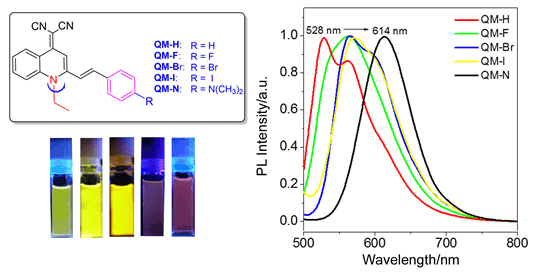| [1] Guo, Z. Q.; Zhu, W. H.; Tian, H. Chem. Commun. 2012, 48, 6073.
[2] Tang, C. W.; VanSlyke, S. A.; Chen, C. H. J. Appl. Phys. 1989, 65, 3610.
[3] (a) Chen, C. H. Chem. Mater. 2004, 16, 4389.
(b) Zhong, H. L.; Lai, H.; Fang, Q. J. Phys. Chem. C 2011, 115, 2423.
[4] Luo, J. D.; Xie, Z. L.; Lam, J. W. Y.; Cheng, L.; Chen, H. Y.; Qiu, C. F.; Kwok, H. S.; Zhan, X. W.; Liu, Y. Q.; Zhu, D. B.; Tang, B. Z. Chem. Commun. 2001, 18, 1740.
[5] (a) Kwok, R. T. K.; Leung, C. W. T.; Lam, J. W. Y.; Tang, B. Z. Chem. Soc. Rev. 2015, 44, 4228.
(b) Mei, J.; Leung, N. L. C.; Kwok, R. T. K.; Lam J. W. Y.; Tang, B. Z. Chem. Rev. 2015, 115, 11718.
(c) Guo, Z. Q.; Shao, A. D.; Zhu, W. H. J. Mater. Chem. C 2016, DOI: 10. 1039/C5TC03369A.
[6] (a) Zhang, X. Q.; Zhang, X. Y.; Yang, B.; Zhang, Y. L.; Wei, Y. ACS Appl. Mater. Interfaces 2014, 6, 3600.
(b) Wang, S.; Zhu, Z.; Wei, D. Q.; Yang, C. L. J. Mater. Chem. C 2015, 3, 11902.
[7] Yao, L.; Zhang, S. T.; Wang, R.; Li, W. J.; Shen, F. Z.; Yang, B.; Ma, Y. G. Angew. Chem., Int. Ed. 2014, 53, 2119.
[8] (a) Hu, F.; Huang, Y. Y.; Zhang, G. X.; Zhao, R.; Yang, H.; Zhang, D. Q. Anal. Chem. 2014, 86, 7987.
(b) Xun, Z. Q.; Tang, H. Y.; Zeng, Y.; Chen, J. P.; Yu, T. J.; Zhang, X. H.; Li, Y. Acta Chim. Sinica 2015, 73, 819. (寻知庆, 唐海云, 曾毅, 陈金平, 于天君, 张小辉, 李嫕, 化学学报, 2015, 73, 819.)
(c) Li, Y. D.; Zhang, H.; Wang, X. C.; Wang, F.; Xia, Y. J. Acta Chim., Sinica 2015, 73, 1055. (李昱达, 张恒, 王迅昶, 汪锋, 夏养君, 化学学报, 2015, 73, 1055.)
[9] Lu, H. G.; Zheng, Y. D.; Zhao, X. W.; Wang, L. J.; Ma, S. Q.; Han, X. Q.; Xu, B.; Tian, W. J.; Gao, H. Angew. Chem. Int. Ed. 2016, 55, 155.
[10] Chi, Z. G.; Zhang, X. Q.; Xu, B. J.; Zhou, X.; Ma, C. P.; Zhang, Y.; Liu, S. W.; Xu, J. R. Chem. Soc. Rev. 2012, 41, 3878.
[11] Huang, J.; Jiang, Y. B.; Yang, J.; Tang, R. L.; Xie, N.; Li, Q. Q.; Kwok, H. S.; Tang, B. Z.; Li, Z. J. Mater. Chem. C 2014, 2, 2028.
[12] Zhang, Y. P.; Li, D. D.; Li, Y.; Yu, J. H. Chem. Sci. 2014, 5, 2710.
[13] (a) Zhang, S.; Qin, A. J.; Sun, J. Z.; Tang, B. Z. Prog. Chem. 2011, 23, 623. (张双, 秦安军, 孙景志, 唐本忠, 化学进展, 2011, 23, 623.)
(b) Zhao, G. S.; Shi, C. X.; Guo, Z. Q.; Zhu, W. H.; Zhu, S. Q. Chin. J. Org. Chem. 2012, 32, 1620. (赵国生, 史川兴, 郭志前, 朱为宏, 朱世琴, 有机化学, 2012, 32, 1620.)
(c) Liu, P.; Chen, D. D.; Feng, X.; Shi, J. B.; Tong, B.; Dong, Y. P. Imag. Sci. Photochem. 2015, 33, 441 (in Chinese). (刘派, 陈笛笛, 冯霄, 石建兵, 佟斌, 董宇平, 影像科学与光化学, 2015, 33, 441.)
(d) Yu, H. B.; Li, H. L.; Zhang, X. F.; Xiao, Y.; Fang, P. J.; Lü, C. J.; Hou, W. Acta Chim. Sinica 2015, 73, 450. (于海波, 李红玲, 张新富, 肖义, 方沛菊, 吕春娇, 侯伟, 化学学报, 2015, 73, 450.)
[14] Shi, C. X.; Guo, Z. Q.; Yan, Y. L.; Zhu, S. Q.; Xie, Y. S.; Zhao, Y. S.; Zhu, W. H.; Tian, H. ACS Appl. Mater. Interfaces 2012, 5, 192.
[15] Shao, A. D.; Guo, Z. Q.; Zhu, S. J.; Zhu, S. Q.; Shi, P.; Tian, H.; Zhu, W. H. Chem. Sci. 2014, 5, 1383.
[16] Shao, A. D.; Xie, Y. S.; Zhu, S. J.; Guo, Z. Q.; Zhu, S. Q.; Guo, J.; James, T. D.; Tian, H.; Zhu, W. H. Angew. Chem., Int. Ed. 2015, 54, 7275.
[17] Yuan, W. Z.; Yu, Z.; Lu, P.; Deng, C.; Lam, J. W. Y.; Wang, Z.; Chen, E.; Ma, Y.; Tang, B. Z. J. Mater. Chem. 2012, 22, 3323.
[18] Shen, X. Y.; Wang, Y. J.; Zhao, E. G.; Yuan, W. Z.; Liu, Y.; Lu, P.; Qin, A. J.; Ma, Y. G.; Sun, J. Z.; Tang, B. Z. J. Phys. Chem. C 2013, 117, 7334. |
